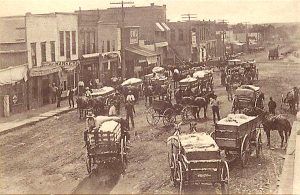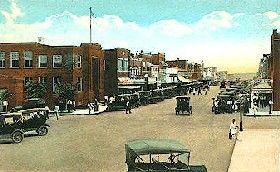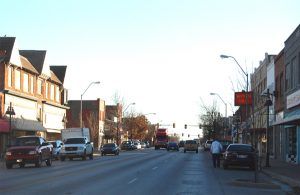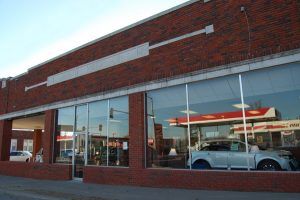About 20 miles beyond Kellyville, Oklahoma, Route 66 travelers heading westward will come to the small town of Bristow, Oklahoma, which got its start in 1897 as a trading post.
The history dates back long before a settlement was formed here. Before 1896, the area around what is now Bristow was part of the Creek Indian Nation. However, in 1896, the Indians were assigned allotments of land and forced to give up the rest so that homesteaders could settle the region.
The following year, the St. Louis and San Francisco Railroad began to extend its tracks from Sapulpa to Oklahoma City. It was then that a small trading post was established. The beauty of the area prompted it to be called the Woodland Queen of Creek Nation. A settlement was not formed until the St. Louis-San Francisco Railroad was due to arrive. On April 25, 1898, a post office was established and named for Kansas Senator Joseph L. Bristow, who was then serving as the fourth Assistant Postmaster General. The first mail was delivered to Bristow on May 30, 1898. The railroad arrived in July 1898, and a small settlement began to grow. The area settlers soon organized and built a small frame school. The following business in Bristow to open was the Territorial Bank by A.H. Purdy, across from the trading post.

Cotton wagons in Bristow, Oklahoma.
In the beginning, most of the area was occupied by Creek Indian owners and white tenant farmers and quickly became known as a little cotton kingdom. Other farms in the surrounding area produced corn, peanuts, potatoes, and fruit. In the 1900 census, the population of Bristow was listed as 626. In 1901, the town was officially surveyed and platted out to include 108 blocks of 12 to 24 lots each. Continuing to grow, the city soon sported seven cotton gins and two cottonseed oil mills.
The town continued to grow, and over the next decade, several buildings and businesses were established, including the Bowman Dry Goods Building and Creek Indian land by a wealthy Englishman, Thomas Cundy. The land where the church was built was initially awarded to a Creek Indian named Ollie Mayes, who sold it to the Indian Territory Diocese of the Episcopal Church on June 5, 1903, for $200. Over the years, the building changed hands several times and is now owned by a private foundation, serving as a venue for weddings and a church museum. The beautiful building displays the original pews and an organ that were already old in 1903 — donated by churches in Oklahoma City and Chandler. Listed on the National Register of Historic Places, the church stands at the corner of 7th and Elm Streets.
The same year, the Coppedge Drug building was built, housing B.T. Coppedge’s drug store; in 1904, a general store was built that would later house the Bristow Record, the first long-term newspaper; and in 1906, the Stone Building was erected — the first brick commercial building in Bristow. Housing a hardware store, A.H. Stone operated the store for over 50 years. These historic buildings also continue to stand in Bristow.

Vintage Bristow, Oklahoma
When Oklahoma became a state in 1907, the city was designated as the Creek County Seat, when its population was 1,134. The county held a special election on August 20, 1908, to decide whether the seat would remain in Bristow or move to, which claimed to be more centrally located. Though Bristow had a larger population and claimed to have better railroad connections, Sapulpa won the election. However, Bristow claimed voting irregularities, and several years later, the election was voided, and a new vote was held on November 20, 1912. Once again, Sapulpa won the election, which finalized the decision for good.
The city continued to grow, and in 1915, oil and gas were discovered in the area, which would provide a boom for the city and its economy. By the 1920s, Bristow was a full-blown oil-boom town as many oil companies established their businesses in or near the city. Over the next decade, the Oklahoma-Southwestern Railway Company built a short line from the oilfields to Bristow, and three refineries and four pipeline companies were established. By 1930, the city reached its peak population of 6,619 people.
During these prosperous years, yet more businesses and buildings were established, including the art deco style Dial-Carman Building, which the Katz Department Store first occupied; the Bristow Floral Co., which was built as offices for the company, and since then has always been utilized for floral businesses; the Modern Hotel, the Bristow Library, the train depot, the Roland Hotel building, which also hosted one of the first radio stations in Oklahoma, and many others that continue to stand.
These were exciting years for Bristow. Not only was the town thriving, but Route 66 also rolled through beginning in 1926. This brought many a traveler through the city that quickly responded with all types of service businesses. It was also during the 1920s that Gene Autry worked briefly as a telegrapher at the Frisco Depot. He later transferred to Sapulpa and then to the station in Chelsea. It was there that he was discovered by Will Rogers. While awaiting the next train, he noticed Autry’s guitar and asked him to play a tune to pass the time. Rogers was so impressed that he mentioned Autry on his national radio show, and from there, Autry became one of the biggest country-western stars of the time. Later, Autry would return to Bristow, where he would broadcast a radio show from the radio station in the Roland Hotel Building.
Though the oil boom had died down by the 1930s and the population dropped over the next several decades, the city continued to thrive, and the town diversified with several manufacturing businesses. By 1970, Bristow was called home to 4,653 people.
Today, Bristow has evolved into a community that offers the best of both worlds – small-town values with city amenities. Agriculture, industry, medicine, and educational sectors employ many of the area citizens. The community of about 4,500 people welcomes visitors to explore its historic buildings and the Town Square that opens onto Historic Route 66/Main Street. Roll along its charming brick streets — in fact, more brick streets than any other town in Oklahoma. To learn more about Bristow and its heritage, be sure to make a stop at the historic 1923 Bristow Train Depot, which houses the Chamber of Commerce and the Bristow Historical Museum. Here, you’ll find railroad-related displays and exhibits about the city’s history and Native American heritage from Indian Territory days to the present. The Chamber of Commerce provides a History Tour brochure that lists 37 buildings and places of historical interest within the city. Just a few of these include the tiny St. George’s Episcopal Church, the state-of-the-art Montfort & Allie B. Jones Library; the fascinating southwestern architecture of the Post Office; and the Wake Island War Memorial located on a 320-acre park on the lake.
For Route 66 enthusiasts, don’t miss the Bristow Motor Co. Building, established in 1923, located at 500 North Main Street. The building, now owned by Bolin Ford, was partially damaged in a massive fire in 2008. But Bolin Ford rebuilt the burned-out portions of the complex, using Art Deco- and Route 66-inspired architecture. The Bristow Tire Shop at 115 West 4th, the Texaco Service Station at 201 West 4th, and the historic Firestone building located at 321 N. Main also remain. Jack Longacre in 2011 restored and renovated the 1930 Firestone building into the Bristow Body Shop, including a vintage-looking neon sign that hangs from the original pole. And if you’re hungry for a bite to eat, Russ’ Ribs at 223 S Main Street is the perfect stop. The restaurant is located in the old Hamburger King building, where Bob Wills and the boys stopped to eat on late-night runs between Tulsa and Oklahoma City.
Continue your journey down Route 66 for another seven miles to tiny little Depew, Oklahoma.

Bristow, Oklahoma Today
More Information:
Bristow Chamber of Commerce
1 Railroad Place
P.O. Box 127
Bristow, Oklahoma
918-367-5151
© Kathy Alexander/Legends of America, updated December 2021.
Also See:
Oklahoma Route 66 Photo Gallery





